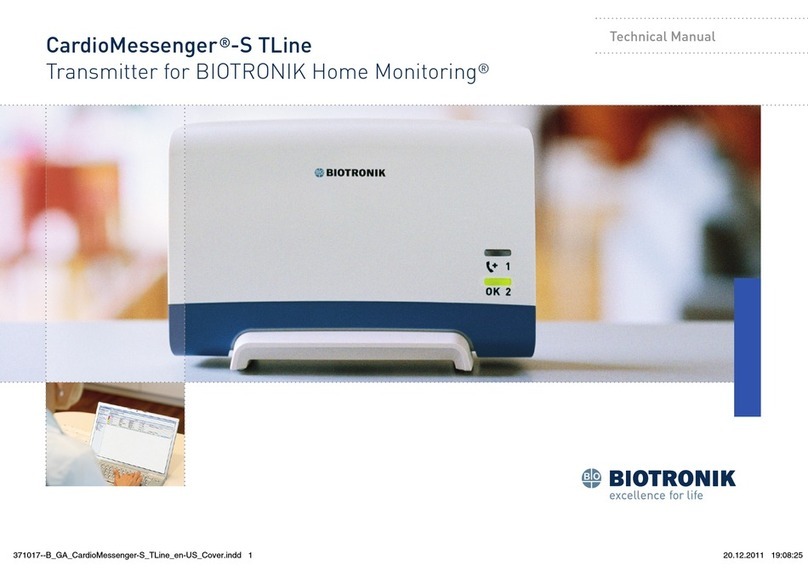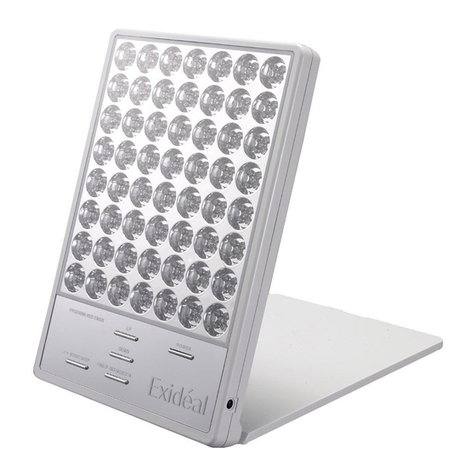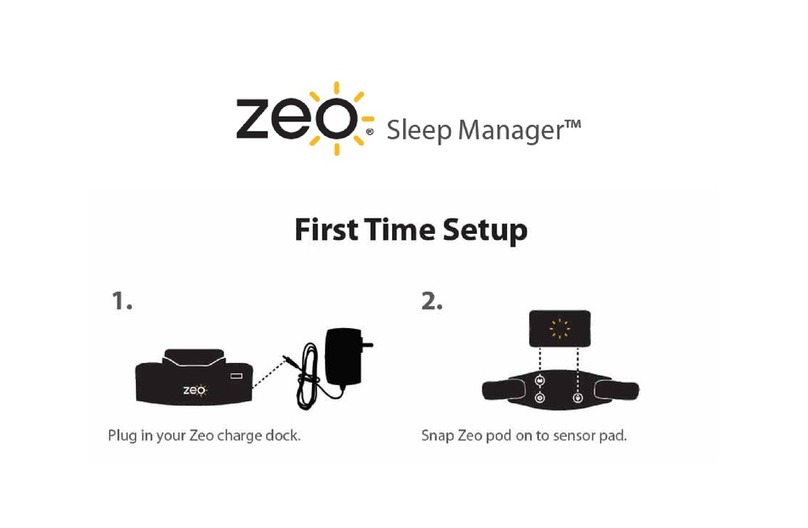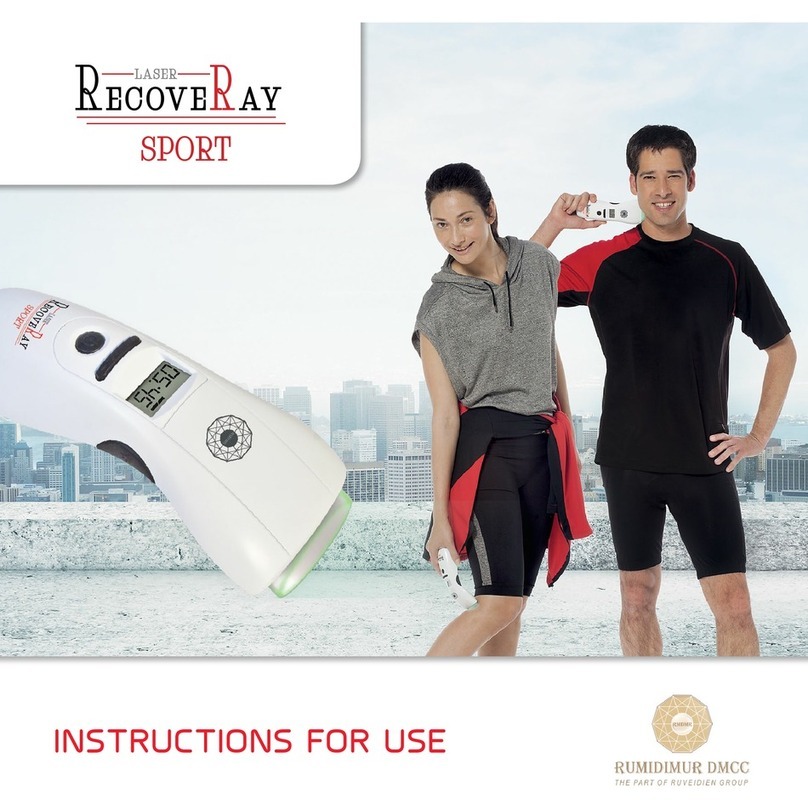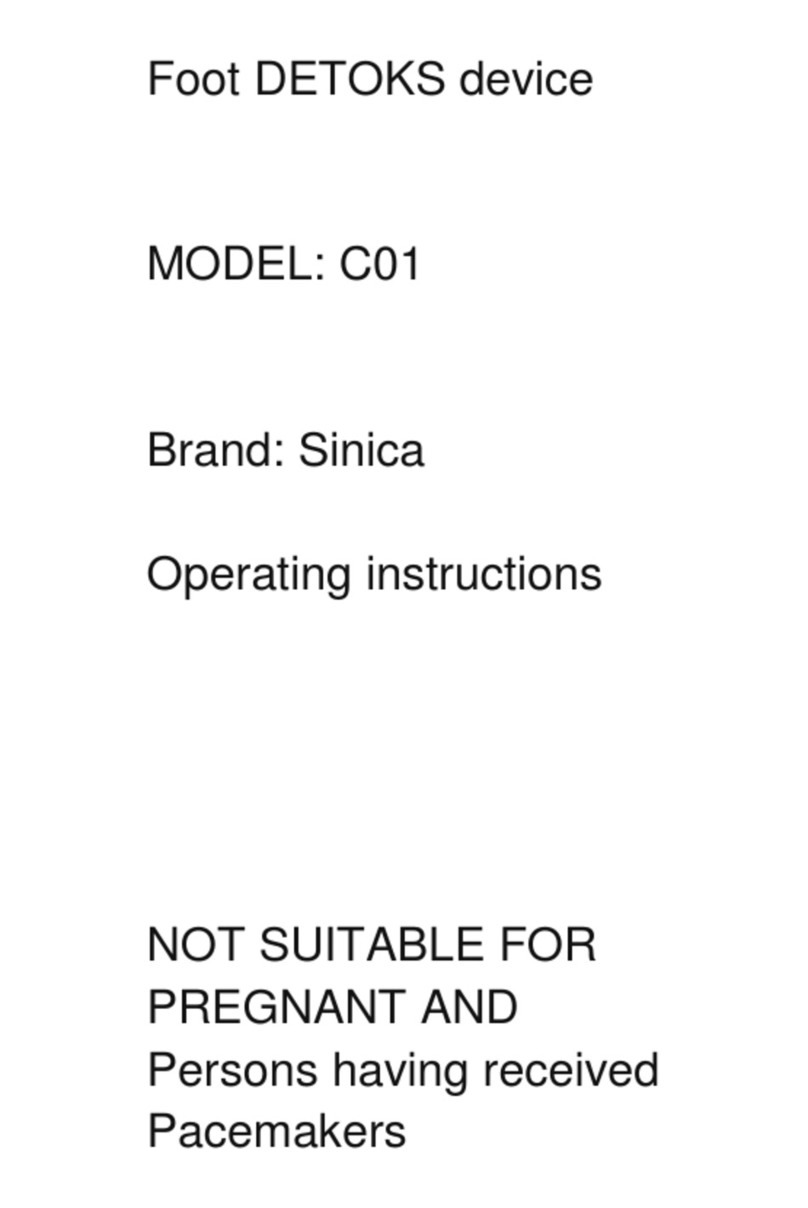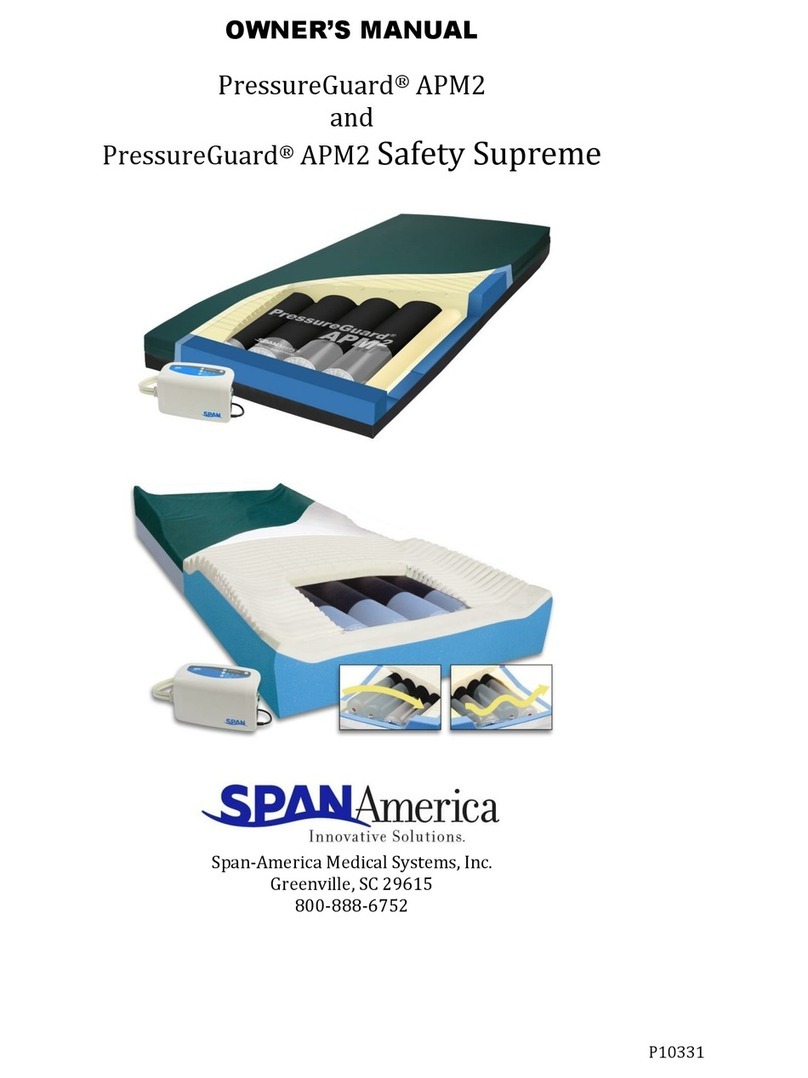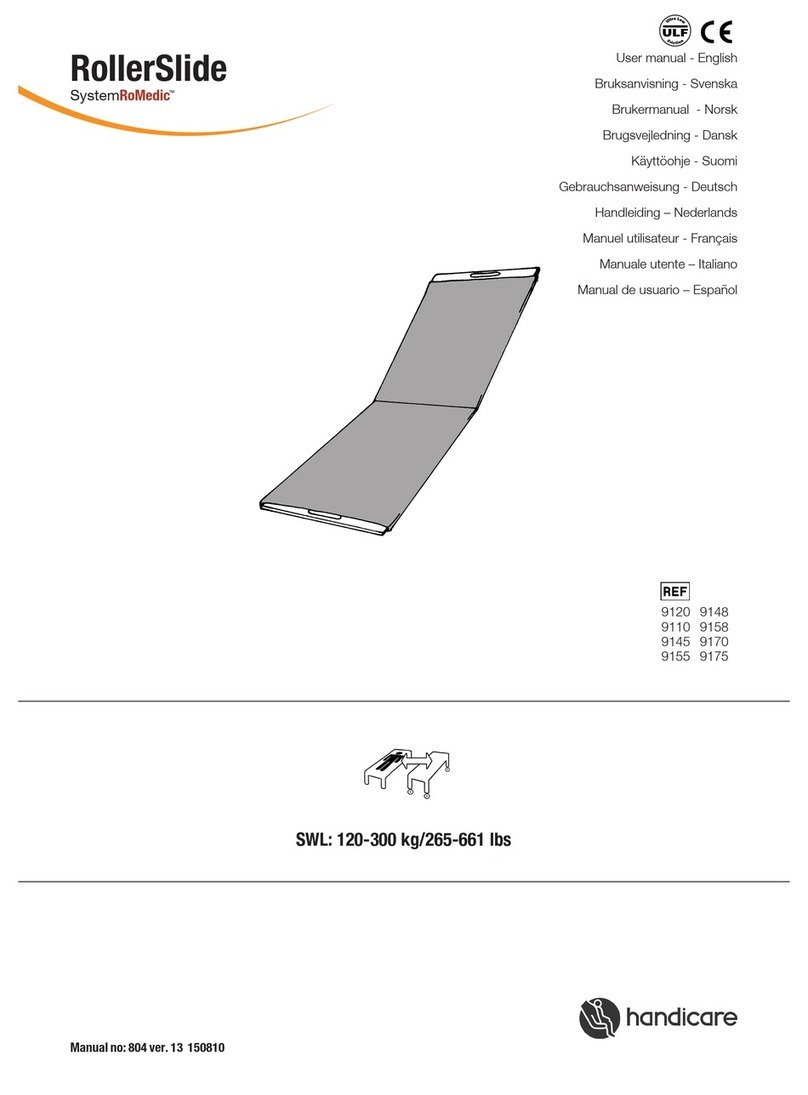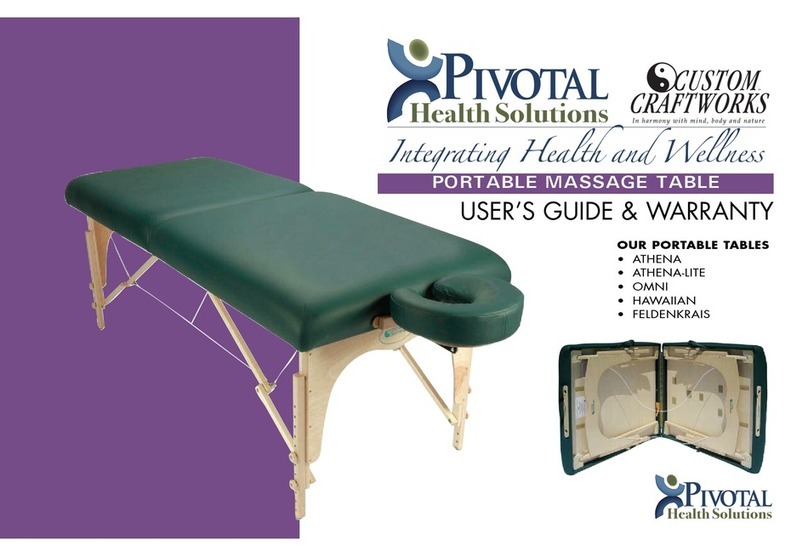Roscoe Medical InTENSity Micro Combo User manual

INSTRUCTION MANUAL

This manual is valid for the InTENSityTM Micro
Combo TENS/MIC Stimulator
This user manual is published by Roscoe Medical, Inc.
Roscoe Medical does not guarantee its contents and reserves the
right to improve and amend it at any time without prior notice.
Amendments may however be published in new editions of this
manual.
All Rights Reserved. Rev. V1.1 © 2013
: United States Federal Law restricts this device to sale by or on
the order of a physician or licensed practitioner.
Conformity to safety standards
Roscoe Medical, Inc. declares that the device complies with the
following normative documents:
IEC60601-1, IEC60601-1-2, IEC60601-2-10, IEC60601-1-4,
ISO10993-5, ISO10993-10, ISO10993-1

3
TABLE OF CONTENTS
1. SAFETY INFORMATION………………………………………………………… 4
1.1 General Description
1.2 Medical background
1.3 Indication for use
1.4 Contraindications
1.5 Warnings, Cautions, Adverse Reactions
2. PRESENTATION..………………………………………………………………..… 11
2.1 Front and Rear panel
2.2 LCD display
3. SPECIFICATION………………………………………............…..……………….. 14
3.1 Accessories
3.2 Technical information
3.3 The waveforms of the stimulation programs
4. INSTRUCTION FOR USE………………………………………………………......17
4.1 Battery
4.2 Connect electrodes to lead wires
4.3 Connect lead wires to device
4.4 Electrode
4.5 Turn ON
4.6 Select the Therapeutic Program
4.7 Steps to set a new program
4.8 Adjust Channel Intensity
4.9 Safety Lock Feature
4.10 Stop the treatment
4.11 Turn OFF
4.12 Low battery indicator
5. PROGRAM………………………………………………………............................ 27
6. CLEANING AND CARE………………………………………………………......... 28
6.1 Tips for skin care
6.2 Cleaning the device
6.3 Electrodes
6.4 Cleaning the Electrodes cables
6.5 Maintenance
7. TROUBLESHOOTING………………………………………………………...... 31
8. STORAGE………………………………………………………......................... 33
9. DISPOSAL……………………………………………................………………. 33
10. ELECTROMAGNETIC COMPATIBILITY (EMC) TABLES…....………………… 34
11. GLOSSARY OF SYMBOLS………………………….….............…………………. 40
12. WARRANTY………………………………………..….................………………... 41

4
1. SAFETY INFORMATION
1.1 General
InTENSityTM Micro Combo is a portable electrotherapy device
featuring two therapeutic modes: Transcutaneous Electrical Nerve
Stimulation (TENS) and Microcurrent (MIC), which are used for pain
relief and electrical muscle stimulation. The stimulator sends gentle
electrical current to underlying nerves and muscle groups via
electrodes applied on the skin. The parameters of the device are
controlled by the buttons on the front panel. The intensity level is
adjustable according to the needs of the individual patient.
1.2 Medical background
EXPLANATION OF PAIN
Pain is a warning system and the body’s method of telling us that
something is wrong. Pain is important; without it abnormal conditions
may go undetected, causing damage or injury to vital parts of our
bodies. Even though pain is a necessary warning signal of trauma or
malfunction in the body, nature may have gone too far in its design.
Aside from its value in diagnosis, long-lasting persistent pain serves
no useful purpose. Pain does not begin until the coded message
travels to the brain where it is decoded, analyzed, and then reacted
to. The pain message travels from the injured area along the small
nerves leading to the spinal cord. Here the message is switched to
different nerves that travel up the spinal cord to the brain. The pain
message is then interpreted, referred back and the pain is felt.
EXPLANATION OF TENS
Transcutaneous Electrical Nerve Stimulation (TENS) is a non-
invasive, drug free method of controlling pain. TENS uses tiny
electrical impulses sent through the skin to nerves to modify your
pain perception. TENS does not cure any physiological problem; it
only helps control the pain. TENS does not work for everyone;
however, in most patients it is effective in reducing or eliminating the
pain, allowing for a return to normal activity.

5
HOW TENS WORKS
There is nothing "magic" about Transcutaneous Electrical Nerve
Stimulations (TENS). TENS is intended to be used to relieve pain.
The TENS unit sends comfortable impulses through the skin that
stimulate the nerve (or nerves) in the treatment area. In many cases,
this stimulation will greatly reduce or eliminate the pain sensation
the patient feels. Pain relief varies by individual patient, mode
selected for therapy, and the type of pain. In many patients, the
reduction or elimination of pain lasts longer than the actual period of
stimulation (sometimes as much as three to four times longer). In
others, pain is only modified while stimulation actually occurs. You
may wish to discuss this method of pain management treatment
with your physician or therapist.
EXPLANATION OF MICROCURRENT
Microcurrent stimulation is a type of therapy in which very low current
is sent into the cells of the body. Microcurrent is a very faint current
that is so small it is measured in millionths of an amp (Microamps).
Human cells generate a current that is in the micro amp range which
is why you can’t feel it – the current is so low it doesn’t stimulate the
sensory nerves.
Microcurrent is a physiological electric modality that increases ATP
(energy) production in the cells of your body. This dramatically
increases the tissue’s healing rate. The immediate response to the
correct microcurrent frequency suggests that other mechanisms are
involved as well. The exact effects or changes in the tissue are
unmistakable; scars will often suddenly soften; trigger points often
become less painful within minutes when the “correct” frequency is
applied. In many situations the changes seen seem to be long lasting
and in many cases permanent.
1.3 Indication for use
InTENSityTM Micro Combo TENS/MIC Stimulator may be used for the
following conditions:
1. Symptomatic relief of chronic pain.
2. Post-traumatic pain.
3. Post-surgical pain.

6
IMPORTANT SAFETY INFORMATION!
Read instruction manual before operating. Be sure to comply
with all “Contraindications”, Warnings”, “Cautions” and
“Adverse reactions” outlined in the manual. Failure to follow
these instructions may cause harm to the user or the device.
1.4 Contraindications
1. This device should not be used for symptomatic local pain relief
unless etiology is established or unless a pain syndrome has
been diagnosed.
2. This device should not be used when cancerous lesions are
present in the treatment area.
3. Stimulation should not be applied over swollen, infected, inflamed
areas or skin eruptions (e.g. phlebitis, thrombophlebitis, varicose
veins, etc.).
4. Electrodes must not be applied to sites that might cause
current/stimulation to flow through the carotid sinus region
(anterior neck) or trans-cerebrally (through the head).
5. Do not use this device if the patient has a demand-type cardiac
pacemaker or any implanted defibrillator.
6. This device should not be used over poorly enervated areas.
7. This device should not be used on patients with epilepsy.
8. This device should not be used on patients with serious arterial
circulatory problems in the lower limbs.
9. This device should not be used on patients with abdominal or
inguinal hernia.
10. Do not use this device if you have heart disease without
consulting your physician.
1.5 Warnings, Cautions and Adverse Reactions
WARNINGS:
1. This device should be used only under the continued supervision
of a licensed physician or practitioner.
2. The long-term effects of chronic electrical stimulation are
unknown. Electrical stimulation devices do not have any curative
value.

7
3. TENS is a symptomatic treatment and, as such, suppresses the
sensation of pain, which would otherwise serve as a protective
mechanism.
4. Safety has not been established for the use of therapeutic
electrical stimulation during pregnancy. Do not use during
pregnancy unless directed by your physician.
5. Electrical stimulation is not effective for pain of central origin,
such as a headache.
6. Electrical monitoring equipment (such as ECG monitors and ECG
alarms) may not operate properly when electrical stimulation is in
use.
7. Stimulation should not be applied over the carotid sinus nerves,
particularly in patients with a known sensitivity to the carotid
sinus reflex.
8. Stimulation should not be applied over the neck or mouth. Severe
spasm of the laryngeal and pharyngeal muscles may occur and
the contraction may be strong enough to close the airway or
cause difficulty in breathing.
9. Stimulation should not be applied transthoracically. Introduction
of electrical current into the heart may cause cardiac arrhythmias.
10. Stimulation should not take place while the user is connected to
high-frequency surgical equipment, it may cause burn injuries on
the skin under the electrodes, as well as problems with the
stimulator.
11. Do not use the stimulator in the vicinity of shortwave or
microwave therapy equipment, since this may affect the output
power of the stimulator.
12. Never use in environments with high humidity such as in the
bathroom or when having a bath or shower.
13. Caution should be used in applying electrical stimulation to
patients suspected of having heart disease. Further clinical data
is needed to show there are no adverse results.
14. Never use near the heart. Stimulation electrodes should never be
placed anywhere on the front of the thorax (marked by ribs and
breastbone), take extreme caution not to place near or on the two
large pectoral muscles. Here it can increase the risk of ventricular
fibrillation and lead to cardiac arrest.
15. Electrodes should not be placed over the eyes, in the mouth,
near the genitals or internally.
16. Never use on the areas of the skin which lack normal sensation.
17. Apply the electrodes to clean, dry, and unbroken skin only.

8
18. Keep electrodes separate during treatment, electrodes in contact
with each other could result in improper stimulation or skin burns.
19. Keep the stimulator out of reach of children.
20. Consult your doctor if you have any questions or concerns before
using this device.
CAUTIONS:
1. Federal law (USA) restricts this device to sale by or on the order
of a physician.
2. This device is for single patient use only.
3. Keep yourself informed of the contraindications.
4. This device is not intended for use on an unattended patient
who is noncompliant, emotionally disturbed, has dementia, or a
low IQ.
5. Read, understand, and practice the warnings, cautions and
operating instructions. Know the limitations and hazards
associated with using this device. Observe the cautionary and
operational decals placed on the unit. Always follow the
operating instructions prescribed by your healthcare practitioner.
6. The instruction of use was listed; any improper use may be
dangerous.
7. Do no use this device for undiagnosed pain syndromes until
consulting a physician.
8. Patients with an implanted electronic device, such as a cardiac
pacemaker, implanted defibrillator, or any other metallic or
electronic device should not use this device without first
consulting a doctor.
9. Stimulation delivered by this device may be sufficient to cause
electrocution. Electrical current of this magnitude must not flow
through the thorax or across the chest because it may cause
cardiac arrhythmia.
10. Do not place electrodes on the front of the throat as spasm of
the Laryngeal and Pharyngeal muscle may occur. Stimulation
over the carotid sinus (neck region) may close the airways,
make breathing difficult, and may have adverse effects on the
heart rhythm or blood pressure.
11. Do not place electrodes on your head or at any sites that may
cause the electrical current to flow trans-cerebrally (through the
head).
12. Patients with heart disease, epilepsy, cancer or any other health

9
condition should not use this device without first consulting a
physician.
13. Some patients may experience skin irritation or hypersensitivity
due to the electrical stimulation or silicone rubber. If rash
develops or pain persists, discontinue use and consult a doctor.
14. Electrode placement and stimulation settings should be based
on the guidance of prescribing practitioner.
15. Effectiveness is highly dependent upon the patient and the
selection of therapy by a person qualified in the management of
pain.
16. Isolated cases of skin irritation have occurred at the site of the
electrode placement following long-term application. If this
occurs, discontinue use and consult your physician.
17. The electrodes are only to be placed on healthy skin. Avoid skin
irritation by ensuring that good contact is achieved between
electrodes and skin.
18. If the stimulation levels are uncomfortable or become
uncomfortable, reduce the stimulation intensity to a comfortable
level and contact your physician if problems persist.
19. This device should not be used while driving, operating
machinery, close to water or during any activity in which
involuntary muscle contractions may put the user at undue risk
for injury.
20. Never use the device in rooms where aerosols (sprays) are
used or pure oxygen is being administered.
21. Do not use it near any highly flammable substances, gases or
explosives.
22. Do not use this device at the same time as other equipment
which sends electrical pulses to your body.
23. Do not confuse the electrode cables and contacts with your
headphones or other devices, and do not connect the
electrodes to other devices.
24. Do not use sharp objects such as pencil point or ballpoint pen to
operate the buttons on the control panel.
25. Inspect applicator cables and associated connectors before
each use.
26. Turn the device off before applying or removing the electrodes.
27. Electrical stimulators should be used only with the leads and
electrodes recommended for use by the manufacturer.
28. This device has no AP/APG protection. Do not use it in the
presence of explosive atmosphere or flammable mixture.

10
ADVERSE REACTIONS:
1. Skin irritation from the electrode gel and electrode burns are
potential adverse reactions. If skin irritation occurs, discontinue
use and consult your physician.
Note: Always use electrodes that are legally marketed and
sold in the United States under 510K guidelines.
2. If the stimulation levels are uncomfortable, reduce the stimulation
intensity to a comfortable level and contact your physician if any
problems persist.

11
2. PRESENTATION
2.1 Front and Rear Panel
1. Output socket: electric signal output after connection of the cable
with adhesive electrodes on Channel 1.
2. Output socket: electrical signal output after connection of the
cable with adhesive electrodes on channel 2.
3. Increases [ ] the output intensity of channel 1. It is also used to
set the application program and the parameter of the waveform in
the setting state.
4. Decreases [ ] the output intensity of channel 1. It is also used
to set the application program and the parameter of the
waveform in the setting state, and to unlock the current treatment
program.
5. Therapeutic mode [M] selection button; it also stops treatment
and exits you out of the setting mode to return to the user
interface.
6. LCD display: Shows the operating state of the device.
7. Increases [ ] the output intensity of channel 2. It is also used to

12
set the application program and the parameter of the waveform in
the setting state.
8. Decreases [] the output intensity of channel 2. It is also used
to set the application program and the parameter of the
waveform in the setting state and unlocks the current treatment
program.
9. Parameter Selection [S] button: press the button to enter setting
state; you can select the different parameters in conjunction with
the up [] and down [] buttons.
10. Press ] to turn ON the device. Press and hold for
approximately 3 seconds to turn off the device.
11. Belt Clip.
12. Battery compartment cover.
13. AC Adapter connection point.

13
2.2 LCD Display
1. Displays therapeutic mode (TENS/MIC).
2. Displays therapeutic program for TENS/MIC (Burst (B), Normal
(N), Modulation (M), and Modulation 1 (M1)).
3. Displays the cycle time for TENS and MIC therapeutic mode in
setting state.
4. Timer symbol
5. Displays waveform pulse width.
6. Displays channel 1.
7. Displays the output intensity for channel 1 (CH1); Displays
waveform pulse rate.
8. The device is locked indicator.
9. Displays waveform pulse rate.
10. Displays the output intensity for channel 2 (CH2); Displays
waveform pulse rate.
11. Displays channel 2.
12. Displays the treatment time.
13. Low-battery indicator

14
3. SPECIFICATION
3.1 Accessories
NO.
DESCRIPTION
QUANTITY
1
Electrical Stimulator Device
1 pieces
2
Electrode Leads
2 pieces
3
1.5” x 1.5” Adhesive Electrodes
4 pieces
4
9V Alkaline Battery, type 6LR61
1 piece
5
Instruction Manual
1 piece
6
Carrying Case
1 piece
7
AC Adapter (optional)
1 piece
3.2 Technical Information
Channel
Dual, isolated between channels.
Power Supply
9.0 V Alkaline DC
-1 x 6LR61 battery.
Adapt
er output: 9.0VDC, 400mA (optional).
Operating
Conditions
5°C to 40°C (41°F to 104°F) with
a relative humidity of
30%
-75%, atmospheric pressure from 700 to 1060 hPa
Storage
Conditions
-
10°C to 50°C (14°F to 122°F) with a relative humidity of
10%
-90%, atmospheric pressure from 700 to 1060 hPa
Dimensions
4.5 (L) x 2.55 (W) x 0.9(H) inches.
Weig
ht
0.28 lbs. (with battery)
Tolerance
There may be a ±5% tolerance of all setting
s and ±10%
tolerance of output intensity.
Timer
Adjustable from 1 to 60 minutes or continuous. Adjusts in 1
minute steps. Treatment time countdown is automatic.
Electrode
D
etection
Function
The amplitude level will be reset to 0mA when the
amplitude level is 12mA or greater and an open circuit at
either channel is detected.

15
Technical specifications for Transcutaneous Electrical Nerve
Stimulator (TENS) Mode
Waveform
Mono
-phase square pulse wave
Pulse Amplitude
Adjustable, 0~105mA peak at 1000 ohm load
each channel, 1mA/step
Pulse Width
Adjustable
from 50 to 300µs, 10µs/step
Pulse Rate
Adjustable, from 1 to 150 Hz, 1 Hz/step
Burst (B)
Burst rate: Adjustable, 0.5 ~ 5Hz
Pulse width adjustable, 50~300µS
Frequency fixed = 100 Hz
Normal (N)
The pulse rate and pulse width are adjustable. It
generates continuous stimulation based on the
setting value.
Pulse Width
Modulation (M)
The pulse width is automatically varied
in a cycle
time. The pulse width is decreased from its original
setting to 60% in setting cycle time, and then
increased from 60% to its original setting in
the next
setting cycle time. In this program, pulse rate (1 to
150Hz), pulse width (50 to 300µS) an
d cycle time (5
to 30 sec) are fully adjustable.
Pulse Rate
Modulation (M1)
The pulse rate is automatically carried in a cycle
time. The pulse rate is decrease from its original
setting to 60% in setting cycle time, and then
increased from 60% to its orig
inal setting in the nest
setting cycle time. In this program, pulse rate (1 to
150Hz), pulse width (50 to 300µS) and cycle time (5
to 30 sec) are fully adjustable.

16
Technical Specifications for Microcurrent (MIC) Mode
Waveform
Mono
-phase square pulse wave
Pulse Amplitude
Adjustable 0~0.7mA
; peak at 1000 ohm load each
channel, 0.01mA/step
Pulse Rate (P.R.)
Adjustable from 0.1Hz to 150Hz; there into,
0.1Hz/step in the range of 0.1Hz~2Hz, 1Hz/step
in the range of 2Hz ~150Hz.
Pulse Width (P.W.)
Adjustable (in correlation to the Pulse Rate),
from 2 to 200ms, 1ms/step
Constant (N)
Constant stimulation based on setting value. Only
pulse width, pulse rate and timer are adjustable in
this program. “Constant” is equal to the “Normal”
mode of a TENS therap
eutic mode.
Pulse Width
Modulation (M)
The pulse width is automatically varied in a cycle
time. The pulse width is decreased from its original
setting to 60% in
the setting cycle time, and then
increased from 60% to its original setting in
the next
s
etting cycle time. In this program, pulse rate (0.1 to
150Hz), pulse width (2 to 200ms) and cycle time (5
to 30 sec) are fully adjustable.
Pulse Rate
Modulation (M1)
The pulse rate is automatically varied in a cycle
time. The pulse rate is decreased from
its original
setting to 60% in setting cycle time, and then
increased from 60% to its original setting in
the next
setting cycle time. In this program, pulse rate (0.1 to
150 Hz), pulse width (2 to 200ms) and cycle time (5
to 30 sec) are fully adjustable.

17
3.3 The Waveforms of the Stimulation Programs
TENS - Burst (B)
TENS - Normal (N)
TENS - Pulse Width Modulation (M)
TENS - Pulse Rate Modulation (M1)
Microcurrent – Constant

18
4. INSTRUCTIONS FOR USE
4.1 Battery
4.1.1 Check/Replace the battery
Over time, in order to ensure the functional safety of the
device, changing the battery is necessary.
1. Slide the battery compartment
cover to open.
2. Insert the 9V battery into the
battery compartment.
3. Make sure you are installing
the battery properly. Be sure to
match the positive and
negative ends of the battery to
the marking in the battery
compartment of the device.
4. Press and push down the battery following the direction
of the arrow indicated on the photo.
5. Replace the battery compartment cover and press to close.
6. If battery requires replacement, slide the battery
compartment cover to open. Pull up the battery following the
directions of the arrow indicated on the photo and insert a
new 9V battery according to the above steps 2 to 5.
4.1.2 Disposal of battery
Dispose of used batteries according to the
current federal, state and local regulations. As
a consumer, you are obligated by law to
discard spent batteries appropriately.
CAUTION:
1. Swallowing a battery may be fatal. Ke ep the battery and the
device out of the reach of children. If a battery is swallowed,
consult a physician immediately.

19
2. If a battery has leaked, avoid contact with skin, eyes and
mucus membranes. Rinse the affected areas with clear water
immediately and contact a physician immediately.
3. Battery should not be charged, dismantled, thrown into fire or
short-circuited.
4. Protect battery from excess heat.
5. Remove batteries from the unit if they are spent or if you are
not using the unit for prolonged periods of time. This prevents
damage caused by leaking battery.
6. Always replace with the same type battery.
4.2 Connect Electrode to Lead Wires
Insert the lead wire connector into electrode connector (standard
0.08 inch female connection). Make sure the connectors are
completely pushed together showing no exposed metal of the pins.
CAUTION:
Always use the electrodes with CE mark, or which are legally
marketed in the U.S. under 510(K) procedure.

20
4.3 Connect Lead Wires to Device
1. Before proceeding to this
step, be sure the device is
completely turned OFF.
2. Insert the wires provided
with the system into the
jack sockets located on top
of the device.
3. Holding the insulated portion of the connector, push the
plug end of the wire into one of the jacks (see drawing);
one or two sets of wires may be used.
4. This device has two output receptacles controlled by Channel
1 and Channel 2 at the top of the unit. You may choose to use
one channel with one pair of lead wires or both channels with
two pairs of lead wires. Using both channels gives the user
the advantage of stimulating two different areas at the same
time.
CAUTION:
Do not insert the plug of the patient lead wire into any AC
power supply socket.
4.4 Electrode
4.4.1 Electrode Options
The electrodes are disposable and should be routinely replaced
before they start to lose their adhesive nature. Replacement
electrodes should be re-ordered through or on the advice of your
physician to ensure proper quality. Follow application procedures
outlined in electrode package to maintain optimal stimulation and to
prevent skin irritation.
Other manuals for InTENSity Micro Combo
1
Table of contents
Popular Health Care Product manuals by other brands
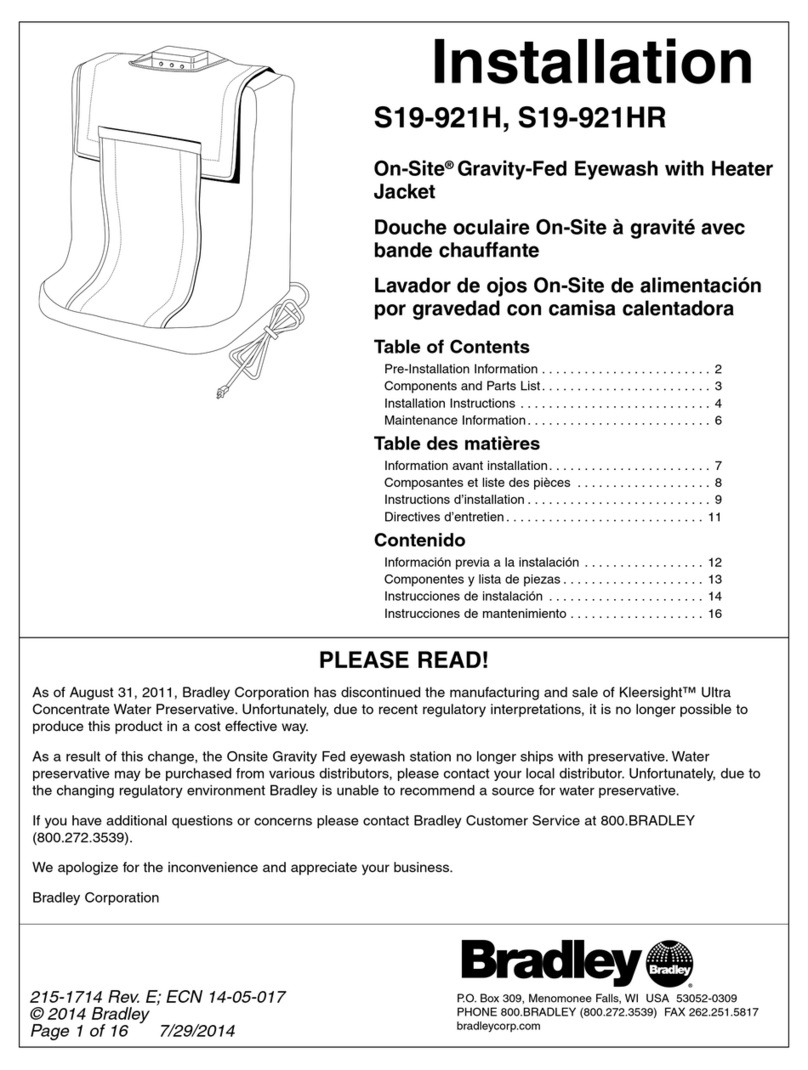
Bradley
Bradley S19-921H Installation
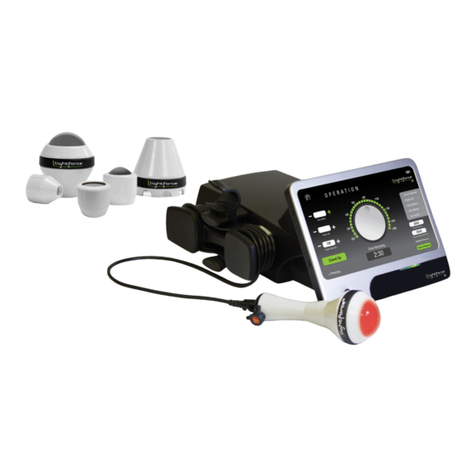
LiteCure Medical
LiteCure Medical LightForce FX user manual
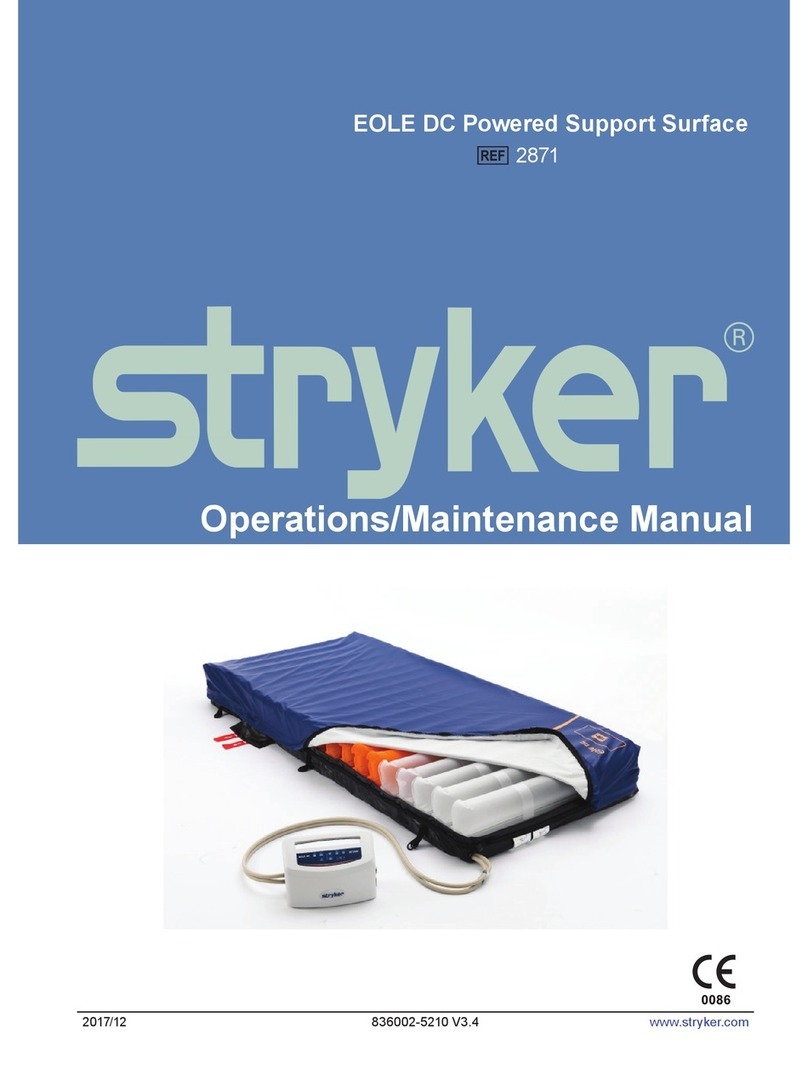
Stryker
Stryker EOLE DC 32" Operation and maintenance manual
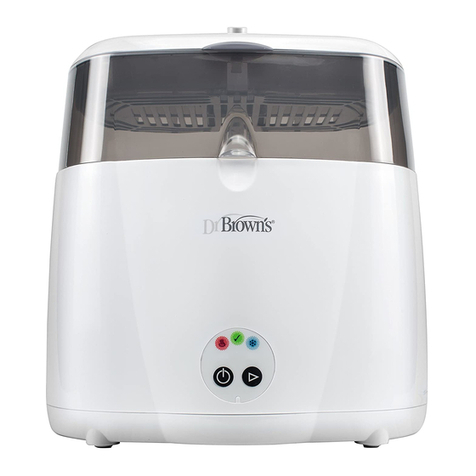
DrBrowns
DrBrowns Deluxe Bottle Sterilizer User instructions
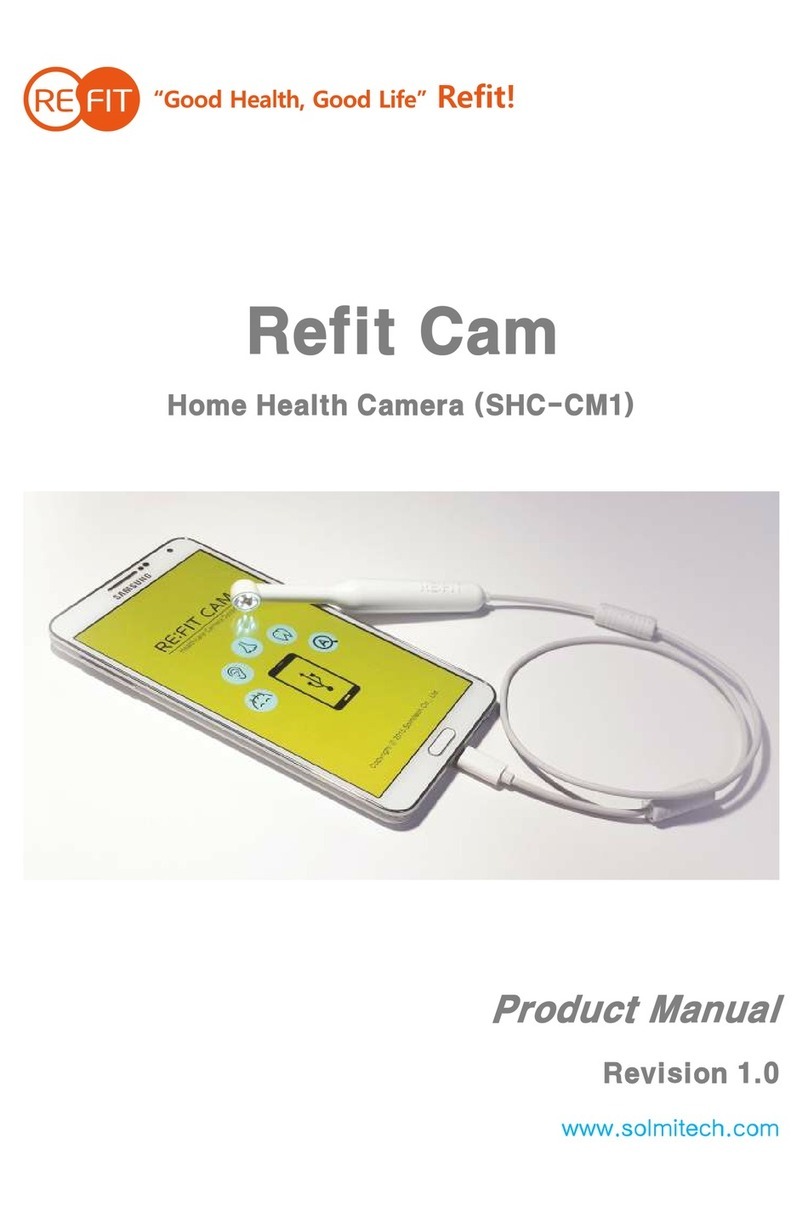
Refit
Refit SHC-CM1 product manual
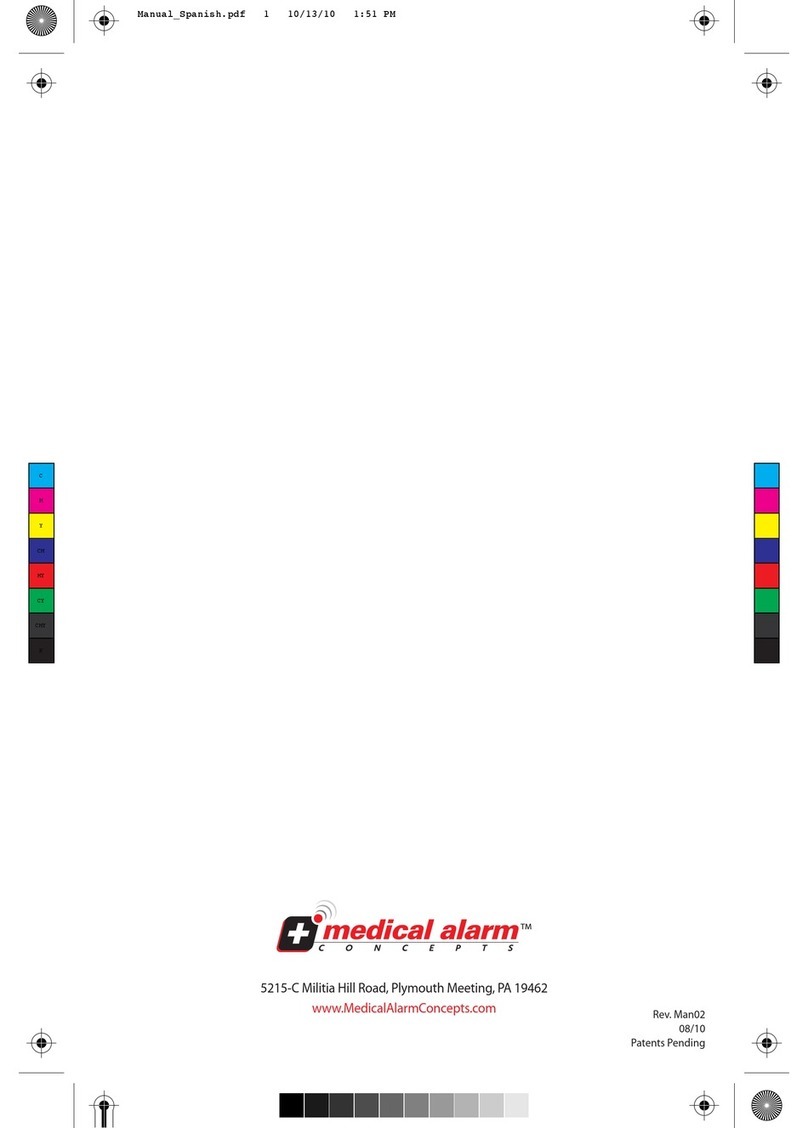
Medical Alarm
Medical Alarm MediPendant MED01 owner's manual
